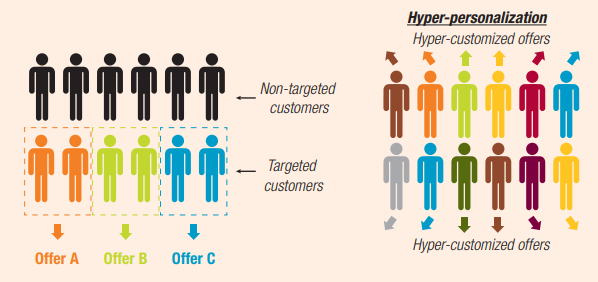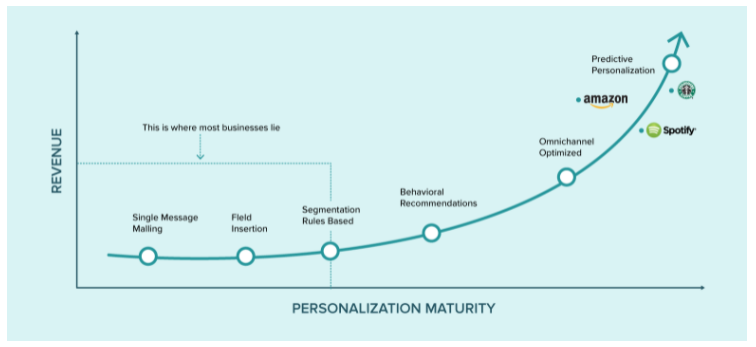Nowadays, customers get targeted with multiple emails, text notifications, social media ads, etc., almost every day with offers and discounts of the products they have been aspiring for recently. Advertisers can now target customers like never before, thanks to data-driven insights. It is the very essence of hyper-personalization.
Hyper-personalization uses general user information as a preliminary step for its analysis, then deploys Artificial Intelligence (AI) and Machine Learning (ML) backed algorithms to get into the brains of a customer. It gathers real-time data, recognizes patterns, and then presents product recommendations, relevant content, and offers based on the findings.
But a new concern is cropping up in the eCommerce space: is this advancing trend towards hyper-personalization a nail in the coffin for creative advertising? Let’s unravel this ongoing debate by understanding whether hyper-personalization is important for enterprises or not.
Why Do You Need Hyper-Personalization for Your Business?
Hyper-personalization aims at creating a personalized channel of relationship and interaction with your customers, but on a more extensive digital scale. You could employ these technologies efficiently to provide a customer experience that leaves a positive impression on your users.
Your visitors are always pressed for time, but they also have a significant amount of disposable income to spend on products and amenities. They expect businesses to identify their changing needs and react based on the information gleaned from real-time analytics. They would love to receive personalized recommendations in their inbox or when visiting your website.
The primary motivation for adopting hyper-personalization is to enhance the customer experience and satisfaction. Other compelling reasons to adopt this next-generation digital marketing strategy include:
- Gather data and statistical insights on customer purchasing behavior and decisions.
- To target different customer and market segments, optimize content development, and gain an edge over the competition.
- Substantiate marketing for ROI goals.
- Utilize customer data for various forms of market research.
Thus, personalization plays a crucial part in driving more sales and revenue numbers without compromising the user experience while they get onboard.
What Is the Scope of Hyper-Personalization?
Hyper-personalization could be applied to the home page, category page, product page, product recommendation, related content, or marketing. You can begin by mitigating your website homepage.
For the sake of saving your customers’ time, your search function should take into account the keywords frequently used by your visitor, past activities, purchasing history, consumer behavior, and so on. To significantly increase the conversion rate, it is imperative to respond to user queries as quickly as possible.
Prominent companies like Amazon, Spotify, Netflix, and Starbucks have progressed to a level of predictive personalization. They harness AI and machine learning technology to assess their user needs and demands based on data insights to fuel their recommendation engine.
What Do Industry Experts Think About Hyper-Personalization?
There is a huge diversity in views about the role of hyper-personalization in the eCommerce, media, and broadcast advertising space. But most of the top company executives have accepted the fact that hyper-personalization is a must for their business growth.
Adam Powers, chief experience officer at Tribal Worldwide London, is also concerned. He addresses that “personalization could probably shrink the spheres of interest of customers even more. That could potentially limit the opportunities for serendipity or random discovery“.
Shadi-Sade Sarreshtehdarzadeh, Ogilvy UK’s strategy director, thinks that “hyper-personalization could be a reason for killing creativity. However, it also has immense potential to bring a brand’s story to life”.
On the other hand, a considerable number of industry leaders believe that hyper-personalization can boost creativity. Digital businesses, according to Patrick Clover, CEO of Scottish company Stampede, require a variety of creative ideas that target certain geographies, media, customers, and scenarios. He further adds that great personalization requires innovative ideas but at an unparalleled scale.
According to Mike Klinkhammer, director of advertising sales for eBay in Europe, the discussion over How brands are using hyper-personalization vs. creativity utterly ignores one of the most critical components in any advertising experience: context. He believes that “businesses need to focus on the context. Otherwise, consumers may find the ad irritating, potentially harming the brand’s reputation”.
Conclusion
Survival in this fiercely competitive online business world demands the implementation of hyper-personalization. No doubt, it can assist you in providing a seamless customer experience and establishing a loyal customer base.
It is preferable to embrace rather than fight this system that is progressively gaining control. Consider how much time and money you would save on market research compared to standard customer data collection methods. The age of hyper-personalization is a fact, not a hypothesis. Use it to your advantage to build stronger consumer relationships.
RecoSense is an AI-powered one-stop destination for end-to-end data intelligence solutions. It leverages AI to deliver rich granular metadata that offers convenience in identifying and working with data instances, including numerous tags that allow businesses to discover a user’s preferences.
This hyper-personalized recommendation bridges the gap between a user’s intention and the recommendations made, thus resulting in increased user engagement.



Leave a Reply